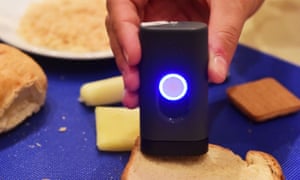A new device that uses similar infrared light to TV remotes can accurately detect fake antimalarial drugs, according to a scientific paper published Monday.
The researchers revealed how they were able to use an optical scanner purchased online for $ 250 to distinguish perfectly between life-saving malaria drugs and deadly counterfeits.
Dozens of public health scientists declared in 2015 that a global crisis of fake drugs was undermining the fight against malaria, tuberculosis and HIV/Aids, particularly in the developing world.
The World Health Organization estimates that falsified medicines represent more than 50% of the pharmaceutical market in several African countries. Ineffective antimalarial drugs alone killed over 120,000 preschool children in Africa in 2013, according to research from the Center for Disease Dynamics.
“We’ve talked to several NGOs and government agencies who would like to do drug quality screening but can’t because they don’t have effective tools,” said Ben Wilson, a research scientist at Global Good, a collaboration between Bill Gates and the technology company Intellectual Ventures.
Wilson’s team, together with researchers at the London School of Hygiene and Tropical Medicine (LSHTM), set out to design an easy-to-use, portable scanner that almost any charity or rural pharmacy could afford.
Many fake drugs are almost indistinguishable from the genuine products, even down to convincing anti-counterfeiting holograms on their packaging. Testing the drugs currently requires laboratory tests with machines costing many thousands of dollars, operated by skilled technicians.
One testing process – spectroscopy – involves shining a light on a material, then analysing the light that comes back. Precise, powerful lasers allow researchers to identify every chemical in a pill, so they can determine which ones contain sufficient artemisinin – the active ingredient in most modern antimalarials.
But Wilson opted for a more rudimentary approach. He bought a spectrometer called Scio from the Israeli startup Consumer Physics, which had crowdfunded the production of the handheld device on Kickstarter. Instead of a laser, Scio uses a cheaper LED light – essentially a souped-up version of the infrared LED in a TV remote.
While infrared spectroscopy cannot pick out the individual drugs that make up a pill, it can capture a medicine’s overall spectral fingerprint. Wilson’s team scanned genuine drugs with sensitive lab equipment, then used machine learning to extract a unique algorithm for each.

Scio connects to a smartphone app that compares those fingerprints to a sample in front of it.
A paper published in the American Journal of Tropical Medicine and Hygiene described lab tests of over 900 samples of antimalarial drugs purchased in Equatorial Guinea and Ghana, in which Global Good’s system detected every single fake.
Global Good and LSHTM want to get handheld scanners like Scio out to workers in the field, where they would connect with a smartphone app the organisation has also developed. Anyone from customs officials to aid workers would be able to scan a drug in seconds, getting an instant readout from the phone whether a medicine is genuine or not.
“Everything is hosted on the phone itself,” said Wilson. “This has to work in remote locations in India or Africa where there is no data service.”
Muhammad Zaman, professor of biomedical engineering and international health at Boston University, agreed that cheap, reliable scanning is essential. However, he argued that substandard drugs, whether the result of poor quality manufacturing or expired supplies, are as much a concern as counterfeit drugs.
“People envisage a mafia working in shadows but the problem is more complicated than that,” he said. “Sometimes good manufacturers make bad drugs because there is no regulation or quality oversight.”
Zaman is developing his own system, called PharmaChk, that squeezes an entire chemical lab into a suitcase. Unlike Global Good’s spectrometer, it destroys the pills it tests, requires a supply of chemicals to operate, and is likely to cost $ 5,000 or more. “But we can tell exactly how much artemisinin is in a sample,” he said.
Global Good’s system has trouble spotting some substandard antimalarials because they still carry the fingerprint of a reputable manufacturer. However, the organisation is already working with a more sophisticated scanner that should be better at identifying poor quality drugs and can even scan pills through a blister pack. If a trial of the new scanner in Laos goes well, Global Good and LSHTM hope to interest a large funding agency in rolling out the technology.
The US Food and Drug Administration is also developing its own handheld scanner to detect counterfeit medicines, and one Chinese company is even building infrared spectroscopy into an Android smartphone.
Ultimately, everyone could one day have the technology to check medicines in the palm of their hands. “The big effort is collecting the data,” Wilson said. “The way our system works, there’s no limit to how many drugs you can scan.”
The Guardian receives funding from the Bill and Melinda Gates Foundation for its Global Development site and homelessness project Outside in America. This news story is unrelated to either of those initiatives.
New weapon in the global fight against fake malaria drugs: a cheap scanner
Hiç yorum yok:
Yorum Gönder